|
|
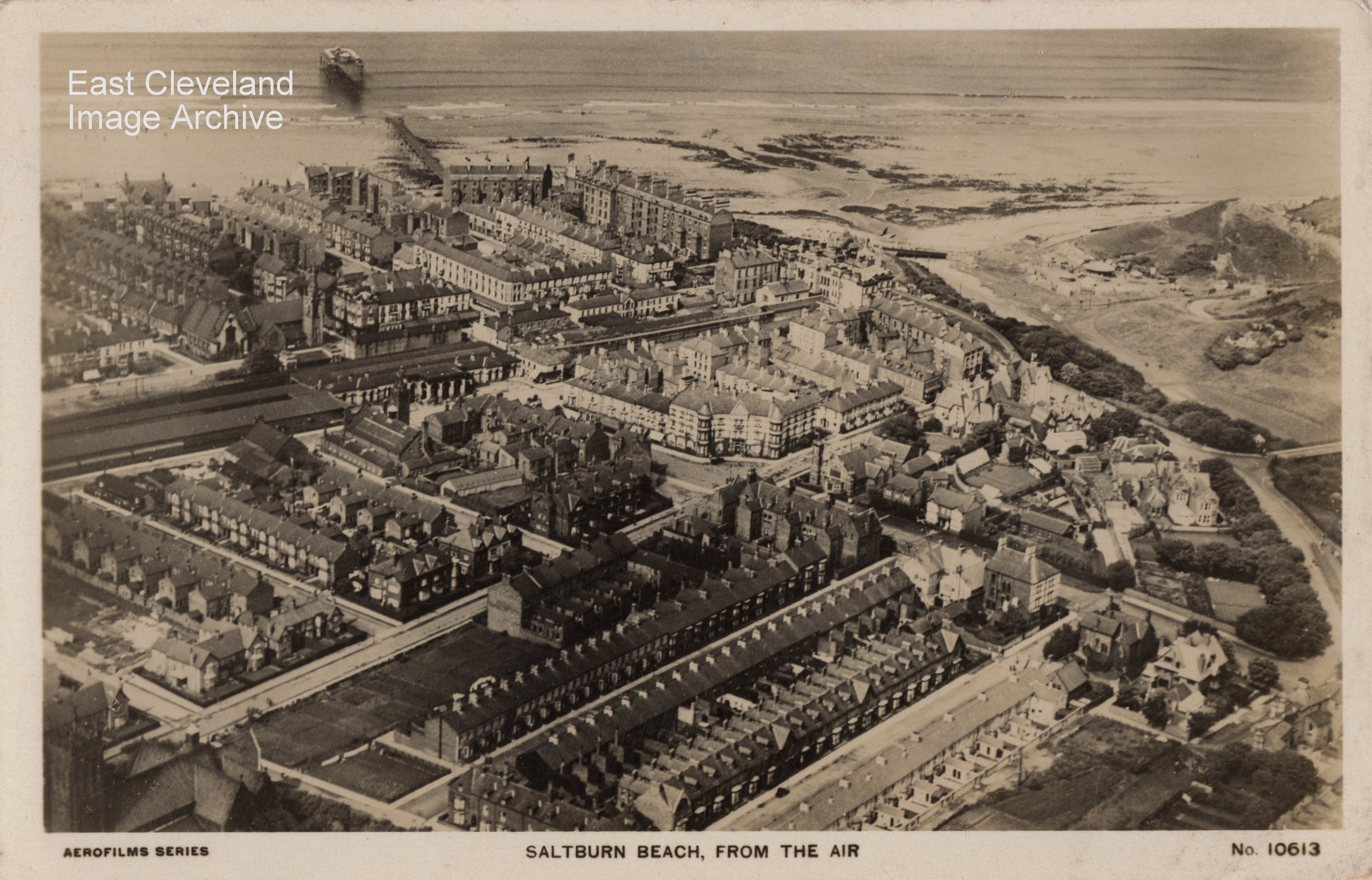
This Aerofilms image of Saltburn (first of a series of five which have come to the Archive) can be dated by the break in the pier, the card is postmarked August 1924, and must have been recently produced to that time. The schooner “Ovenbeg” broke a 70 metre gap in the pier on 8th May 1924, so would have been produced shortly after the boat had been removed from the beach. Note the space between Emmanuel church and the south side of Windsor Road which appears to be allotment gardens; also the covered platform of the railway station.
Image courtesy of Julie Tyrka.
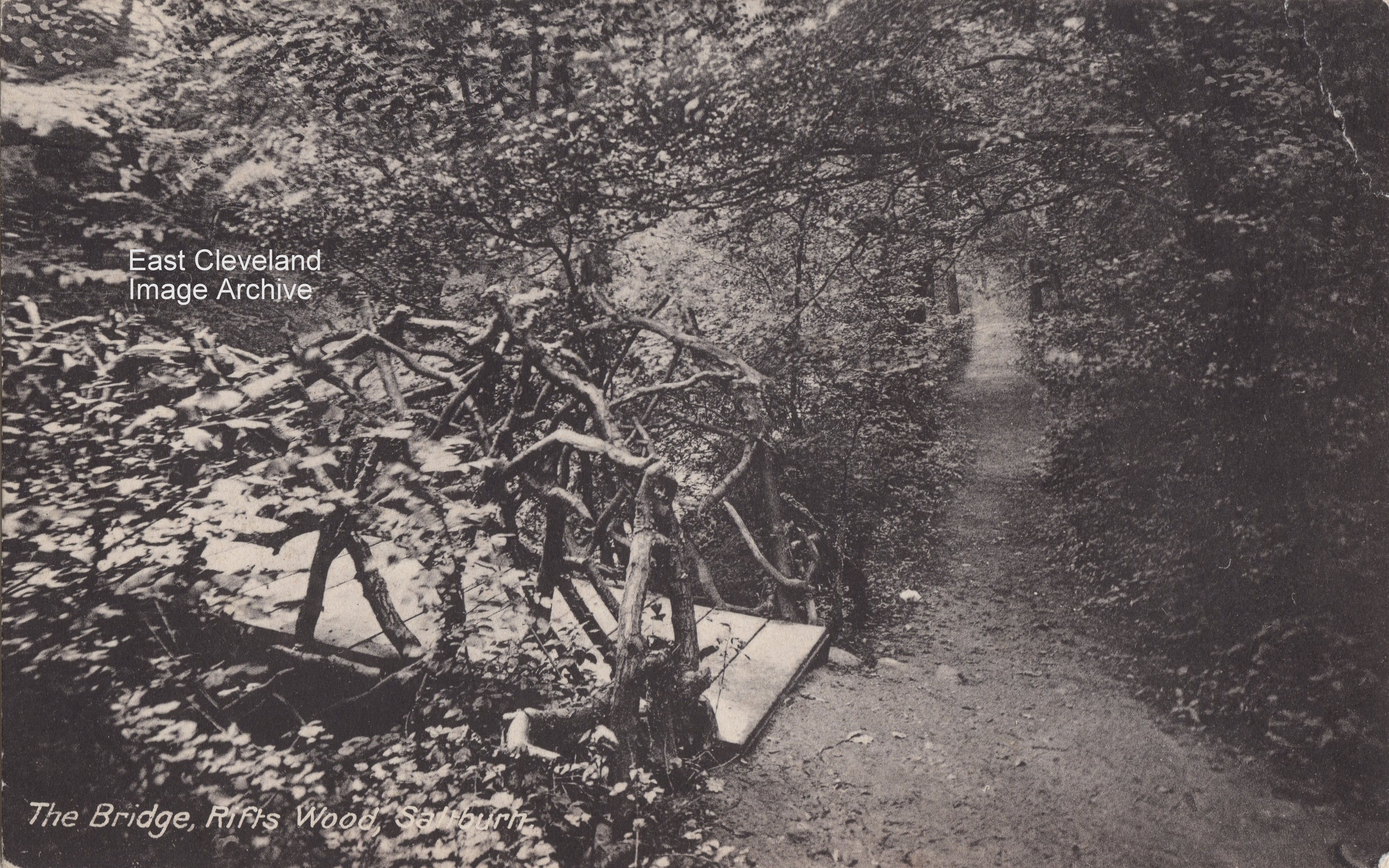
Who else has memories of this bridge, spanning Skelton Beck from Riftswood to the grounds of Rushpool Hall? Intriguingly it could be crossed but exiting into Rushpool Hall grounds required getting past the board door which was always locked! However by ways and means it was possible to get across and enter what was to many a ‘forbidden garden’. The image comes from an unused postcard, alas it bears no identification, but is believed to date from the early 20th century; certainly the bridge was there in the 1950s and 1960s. Alan Collins tells us: “I remember that this bridge existed between 1950 until about 1957 when I lived at 8 Victoria Road, opposite the Youth Hostel. For me and my brother David and sister Rosina, Riftswood was our favourite playground and we knew every inch of it from the sea right up to the golf course, past the water falls under the railway viaduct… where I found a proper tree house – with a wood burning stove – reached through a trapdoor with a rope ladder. Yes; the door was always locked but we used to shin across a fallen tree trunk to explore the ‘secret gardens’ at Rushpool. I once spoke to a soldier there; the whole place was used as a special mental hospital just for military personnel. The nurses used to tend them sunbathing there. They did tell me that I was not allowed to be there, but a sign on the bridge said Private No Entry! There was another way to get there from the Fairy Glens, at the bottom of a path from Victoria Road. The water mill and farmhouse had not long been abandoned at the downward end of the leat from the waterfall”. David Hill confirms with: “I can also remember the bridge, it was still there in 1962. When Rushpool Hall was not in use I used the bridge and paths through the grounds to walk to work at Woodlands Nursery opposite the Skelton Road entrance to Rushpool Hall. If you look carefully you can still see where the bridge used to be. In the ‘secret garden’ there is a Sequoiadendron giganteum (Giant Redwood) tree which because of its bark we used to call the “punch tree”; if punched the bark is soft. Further towards the hall and to the left there used to be some dogs graves, does anyone know if they are still there? Saltburn is a great place to spend one’s childhood, woods, rivers,coast, cliffs, very happy memories”.
Image courtesy of Julie Tyrka and thanks to Alan Collins and David Hill for the updates.
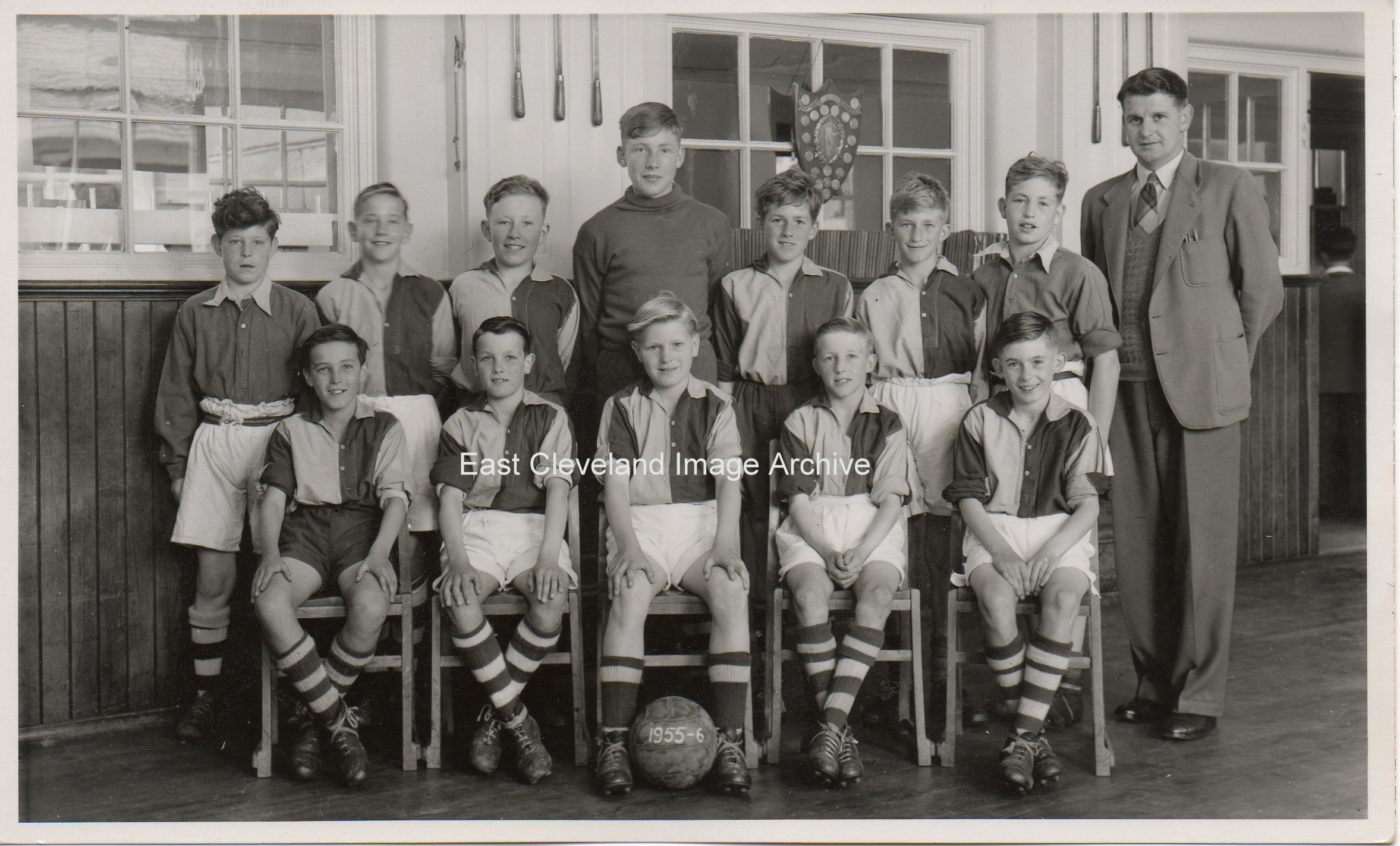
Loftus County Modern Football team 1955 – 56, were obviously winners; but we needed help! Easily identifiable was Mr Stephenson, although there were some names; thanks for the assstance with the rest! But what was the trophy in the background?
Back row: Herbie Holliday Jackson, Terry Kentfield, Alan Jackson, Eric Lancaster (goalkeeper), John Mead, William Morrish, Robert Jackson, Mr Maurice (Zac) Stephenson.
Front row: Frank Chapman, Neil Dale, Tony Walker, Fred Cuthbert, Colin Fenby.
Image courtesy of the Pem Holliday Collection and thanks for assistance with names to date to Margaret and Bill Shaw, Marjorie Magor, Sylvia Auckland, Eric Johnson and Ken Fawcett.

The Archive has been requested to undertake some research of an images for the Cleveland Ironstone Mining Museum; it is displayed above! The image is part of the extensive collection of photographs which the Mining Museum holds, but the Museum is unsure of the relevance or reason for inclusion in their collection. It is believed to be two brothers who were part of a music hall act popular on Northern music hall stages; but the Archive would welcome any information to support or disprove this theory. Please help us!!!
Image courtesy of Cleveland Ironstone Mining Museum.
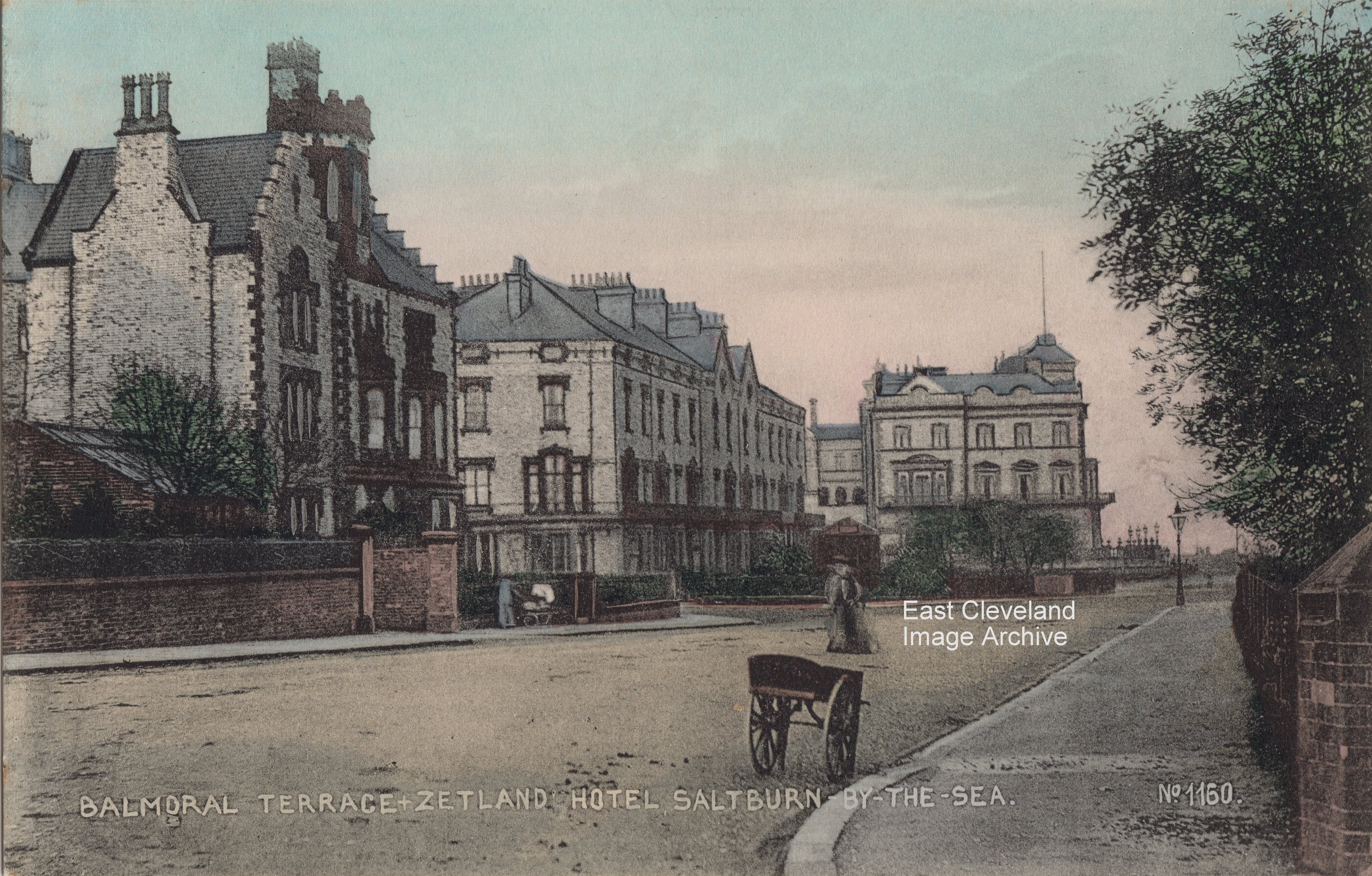
A further Phoenix postcard view from Glenside towards Balmoral Terrace and the Zetland Hotel; all the buildings were faced with the distinctive Pease bricks, a feature of many of the buildings in this ‘planned’ seaside resort. Brittain and Wright of Stockton; who produced the Phoenix series would not have far to travel to undertake any photography for this series of images of Saltburn; just hop on the train in Stockton and down the line to Saltburn! Balmoral Terrace was just across the end of Windsor Road (the Towers being on the opposite corner); the first houses on Balmoral Terrace served for many years as the dormitories for boarders at the Towers school), as the school was listed in Bulmers Directory of 1890 it would be in business at a similar time as this image.Callum Duff advises: “Saltburn was not in fact ‘planned’ to be a seaside resort. George Dickenson’s original plans for the town did not include beach amenities and access to this part of town was discouraged. The main attraction was The Valley Gardens and property overlooking this feature was considered most desirable. George Dickenson was replaced by John Anderson in 1867 and it is he that we should thank for developing beach facilities. Having been refused permission by the SIC to build a hotel on both Glenside and on the opposite corner of Milton Street, adjacent to The Zetland Hotel, Anderson was left with the option of developing a sizeable site on the soon to be named, Britannia Terrace. With no view of the valley to speak of, Anderson needed his own attraction and instigated the formation of the Saltburn Pier Company after a meeting at his newly-opened Alexandra Hotel in October 1867. This is why Saltburn Pier was built directly in front of the hotel. Balmoral Terrace is its own entity between Glenside (pictured here) and Dundas Street East. They are the first houses and also the last!” Callum also advises on another claim to fame for Balmoral Terrace: “Chris Scott Wilson says in his book, ‘The History of Saltburn’ says ‘After Alexander Graham Bell demonstrated his invention called ‘The Telephone’ at the Philadelphia Exhibition in 1876, one of the first telephone calls is believed to have been made in Saltburn. After reading of Bell’s invention, a Mr Irvine built one himself. While staying at Sir Francis Fox’s house ‘Cliffden’, he connected a line to Judge Ayrton’s house in Balmoral Terrace over the Ha’penny Bridge and they had a conversation’.”
Image courtesy of Julie Tyrka and thanks to Callum Duff for the updates.
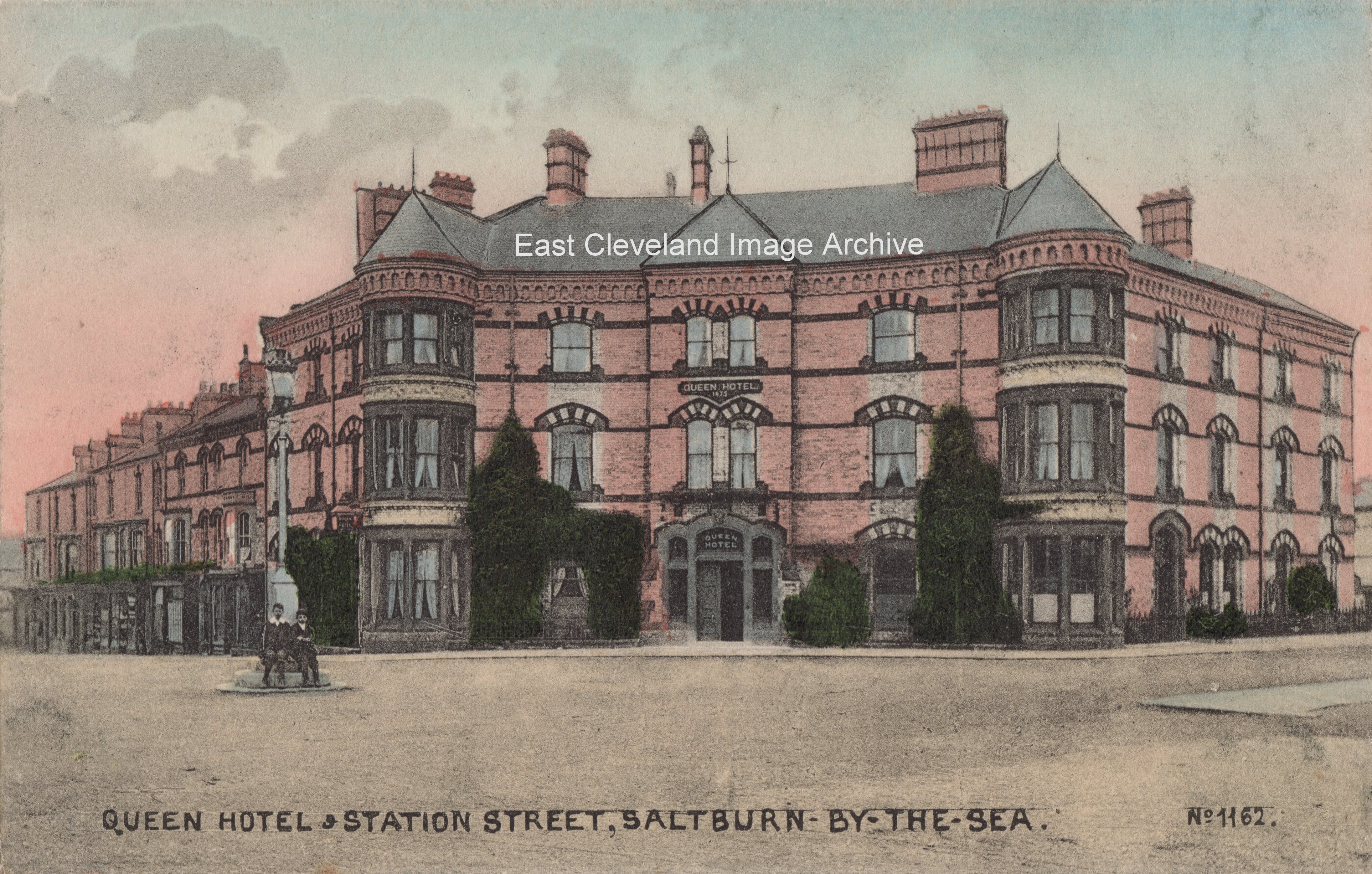
A Phoenix series postcard view of the Queen hotel dating from c.1905; the impressive frontage of the Queen’s Hotel was angled and originally envisaged to form one part of a ‘circus’ of buildings, close to the approach road to the town’s railway station. Only one side of this ‘circus’ was ever completed; the Queen’s Hotel is built in distinctive white ‘Pease’ brick as is found in many buildings in the town. Known today by many residents as “The Swingdoors” the building was intended as part of an impressive approach to the railway station entrance.
Obviously quiet enough for the two young men to sit on the lamp-post base, undisturbed by possible passing traffic; it would not be possible in today’s traffic.
Image courtesy of Juli Turka.
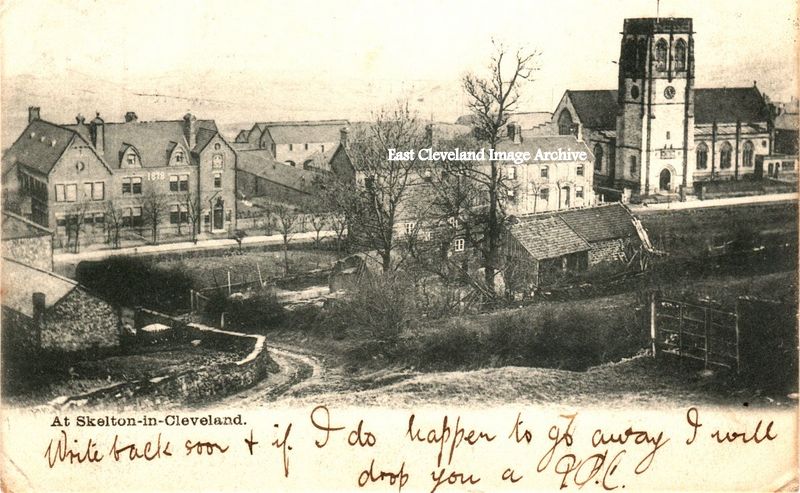
A further postcard view of Skelton High Street, with the Wharton Arms and All Saints Church viewed over Egg Cup farm; the then muddy lane to The Hills is now a metalled public road. Note also the trees planted in front of the Wharton Arms, I wonder how long they lasted? Peter Appleton assists with: “If my memory is not letting me down, they were still there in the 1950s. But perhaps, I’m wrong.” Owen Rooks advises: “I agree with you, Peter. I can remember the trees being there into the early 1950’s as well. They went from the Wharton Arms up to the entrance to Home Farm next to the church. Egg Cup Farm was occupied then by Eddie Dunning who used his ancient saloon car as a taxi; he took me and my family to Saltburn station on several occasions. In between times, judging by the aromas within it, I think he used the same car to transport his livestock! The building with its gable end pointing towards the camera at the extreme left of the picture was in my youth butcher Bob Young’s abattoir and his shop was on the High Street at the other side of the back lane. I and some of my mates once watched Butcher Young at work there, from a distance but within eye and earshot of the attendant sights and sounds. Kids weren’t wrapped up in cotton wool in those days!” Peter Appleton adds: “I recall watching him at work, too. I lived in Robinson Street (beside the church) and went to junior school at Skelton Green. If Bob was busy slaughtering and butchering as I walked down from The Hills on my way home, I’d stop off and watch him.”
Image courtesy of Peter Appleton, thanks to Owen Rooks and Peter Appleton for the updates.
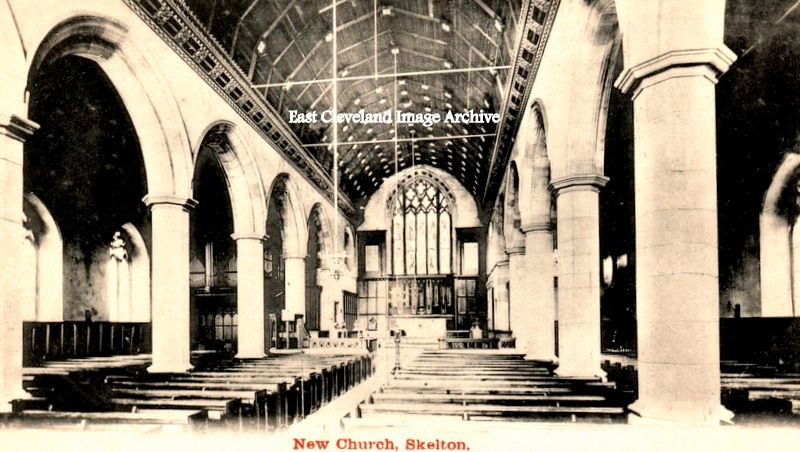 A postcard view of the interior of Skelton’s All Saints church; built in 1884 to replace the old All Saints church which still stands close to Skelton Castle. In June 1884 the new pulpit was installed; “designed by R. J. Johnson architect of Newcastle it is octagonal in form on a curved stone base”. This magnificent church still stands proud beside the High Street, the stone now more darkened than when first built. A postcard view of the interior of Skelton’s All Saints church; built in 1884 to replace the old All Saints church which still stands close to Skelton Castle. In June 1884 the new pulpit was installed; “designed by R. J. Johnson architect of Newcastle it is octagonal in form on a curved stone base”. This magnificent church still stands proud beside the High Street, the stone now more darkened than when first built.
Image courtesy of Peter Appleton, additional information courtesy of Bill Danby’s ‘History of Skelton in Cleveland’.
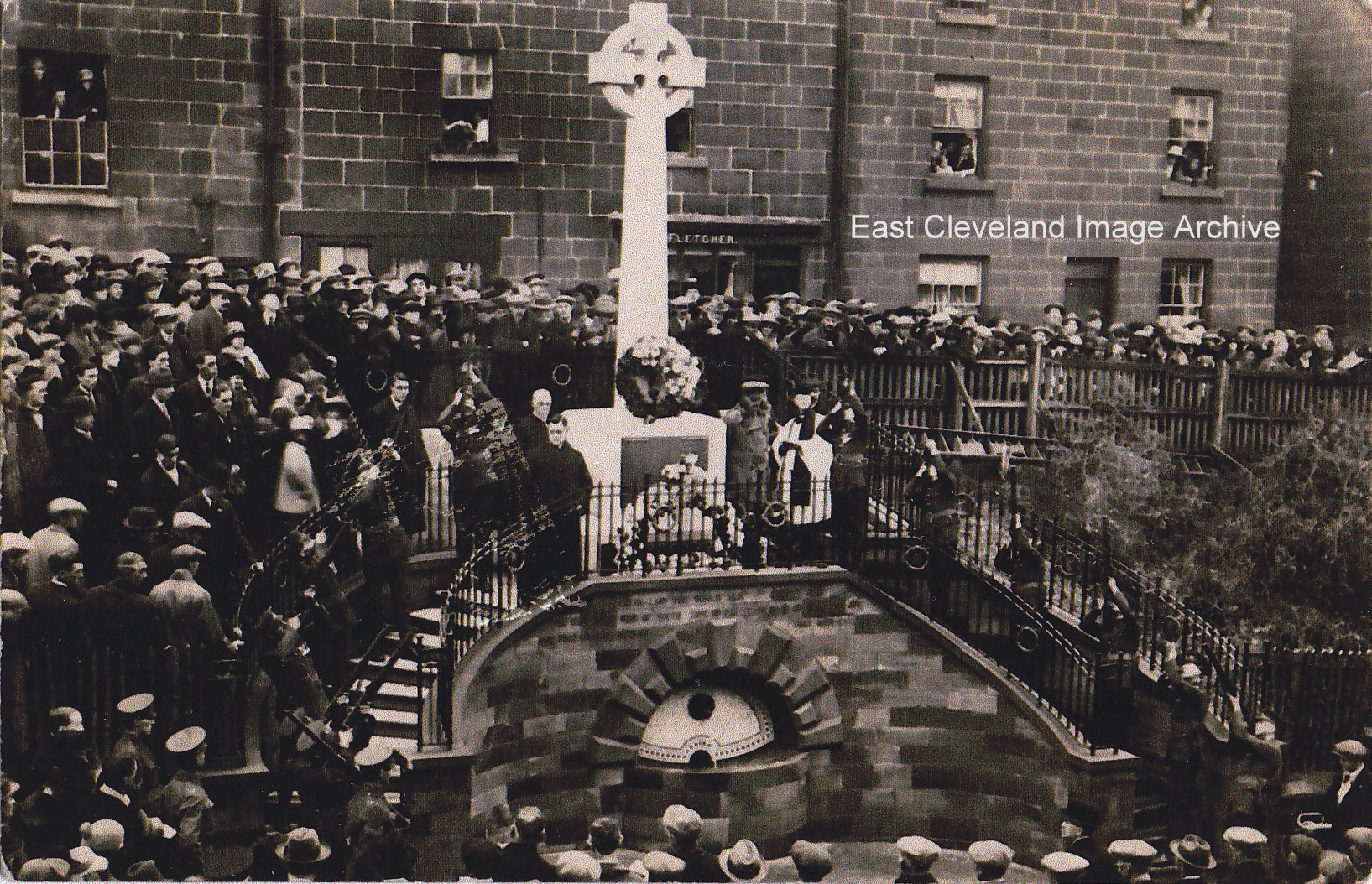
At 2pm on 11th November, 1922, (one year after the end of registration of deaths due to the War or its effects), the Memorial at Loftus was formally consecrated. Built by Mr. C. Hebditch the Celtic Cross, to a design by B J Wormleighton;made of Cornish granite, stands on a site in the High Street donated by Lord Zetland. Mrs. G. Locker (who lost two sons in the conflict) and Mr. W. Hoggarth D.C.M. performed the unveiling of the monument that commemorates the dead of the First World War. The total cost of £815 was raised by donations and collections. Sir Hugh Bell was guest speaker, the service was conducted by ministers of all religions, each taking a part of the service.
The guard of honour and firing party was provided by 4th Battalion, Queen Alexander’s Own, the Yorkshire Regiment, also known as the Green Howards. The local Battalion of the local Regiment had recruited so many of the men whose names were inscribed on the bronze tablets at the base of the Celtic Cross.
In the background can be seen Oliver’s buildings – a house and a coachhouse, a butcher’s shop and three cottages – which were owned by the Catholic Church and later demolished.
Image courtesy of Eileen Hicks and many thanks to Stuart Cole for information regarding the guard of honour and firing party.
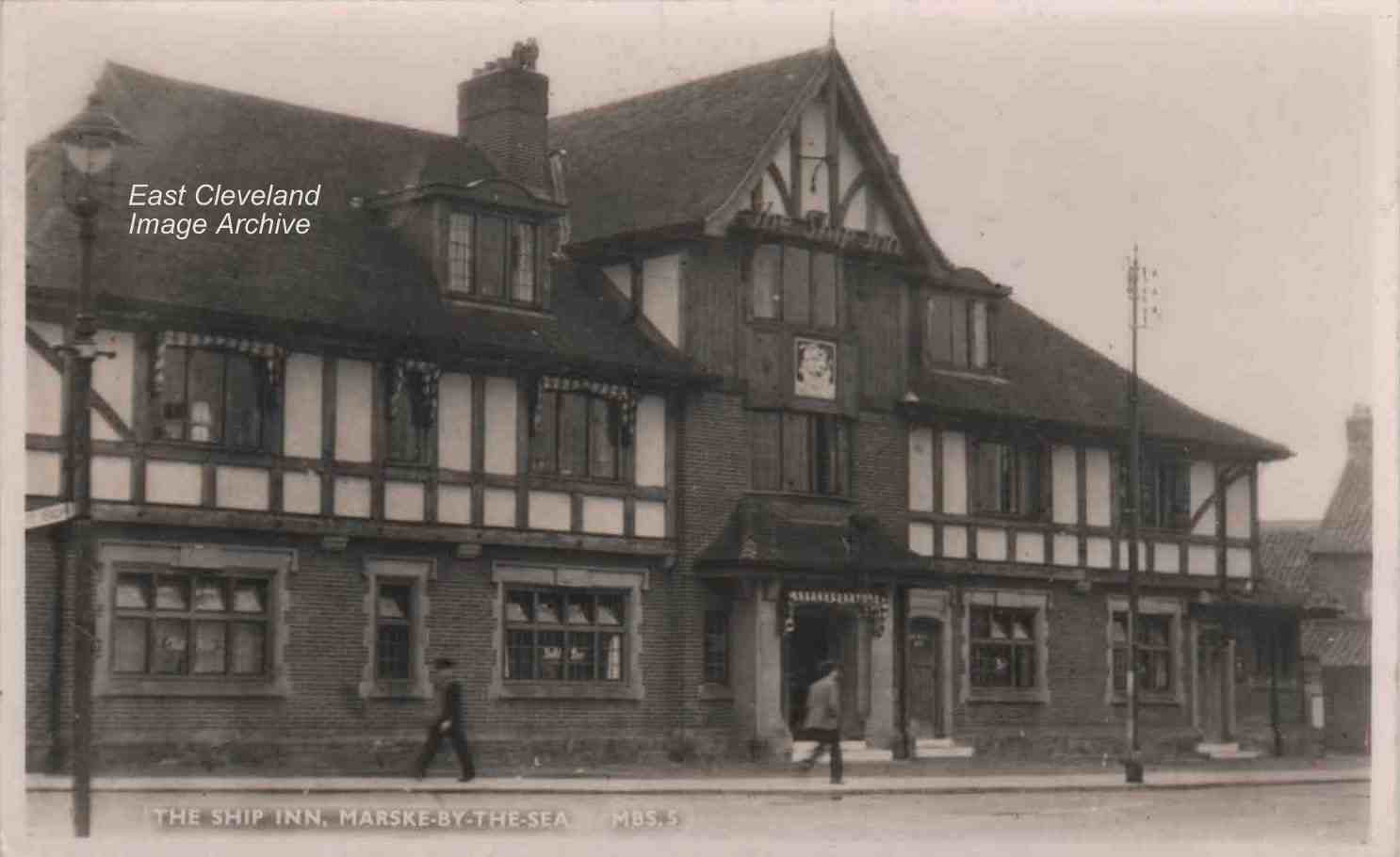
A postcard view of The Ship Inn Marske, this popular village amenity is a Grade II listed building and described in the Listed British Buildings as: “A very complete example of an Inter-War, Roadhouse type public house.” The building was dating from 1932, although this was a site on which have stood a succession of similarly named buildings. The mock Tudor timber framing originated from the battleships HMS Collingwood and HMS Southampton; the two battleships being scrapped between 1909 and 1912 by Hughes-Bolckow in the north east of England.
Image courtesy of John G. Hannah.
|
|







 A postcard view of the interior of Skelton’s All Saints church; built in 1884 to replace the old All Saints church which still stands close to Skelton Castle. In June 1884 the new pulpit was installed; “designed by R. J. Johnson architect of Newcastle it is octagonal in form on a curved stone base”. This magnificent church still stands proud beside the High Street, the stone now more darkened than when first built.
A postcard view of the interior of Skelton’s All Saints church; built in 1884 to replace the old All Saints church which still stands close to Skelton Castle. In June 1884 the new pulpit was installed; “designed by R. J. Johnson architect of Newcastle it is octagonal in form on a curved stone base”. This magnificent church still stands proud beside the High Street, the stone now more darkened than when first built.

Recent Comments